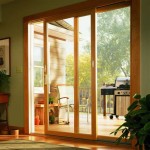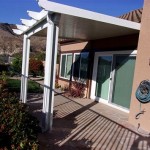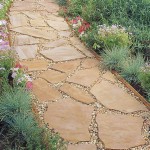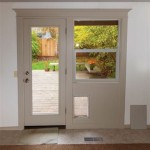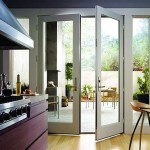Fixing a Sliding Patio Door Track: A Comprehensive Guide
A sliding patio door provides convenient access to outdoor spaces, allowing natural light and fresh air to flow into a home. However, a malfunctioning sliding door, particularly one with a damaged or dirty track, can be a significant source of frustration. A sticky, noisy, or completely stuck sliding door is often a symptom of track issues. This article provides a comprehensive guide to identifying and rectifying common problems associated with sliding patio door tracks.
Before attempting any repairs, gather necessary tools and materials. These typically include a putty knife or similar flat tool for removing debris, a vacuum cleaner with a hose attachment, a wire brush, appropriate cleaning solutions (such as mild soap and water, or a specialized track cleaner), lubricant (silicone-based or Teflon-based are recommended), a screwdriver (Phillips and flathead), pliers, and safety glasses. Proper preparation ensures a safe and efficient repair process.
Identifying Common Track Problems
The first step in resolving a sliding patio door issue is to accurately diagnose the root cause. Track problems manifest in various ways, each requiring a specific solution. Common issues include:
Debris Accumulation: This is the most frequent reason for a sticky sliding door. Dirt, dust, leaves, insects, and even pet hair can accumulate within the track, creating friction and impeding the smooth movement of the rollers. This build-up acts as a physical barrier, preventing the door from gliding effortlessly.
Damaged Tracks: Over time, the metal or vinyl tracks can become bent, dented, or corroded. Constant use and exposure to the elements can contribute to this type of damage. Dents and bends create uneven surfaces that the rollers must navigate, leading to a jerky or stuck door. Corrosion, particularly in metal tracks, can also significantly hinder movement.
Roller Issues: While technically not a track problem, worn-out or misaligned rollers directly impact the track's functionality. If the rollers are damaged, they cannot smoothly glide along the track, leading to increased friction and difficulty in opening or closing the door. Misaligned rollers may also cause the door to rub against the frame or track, creating further resistance.
Drainage Problems: Many sliding door tracks incorporate drainage holes to prevent water accumulation. If these holes become clogged, water can pool in the track, leading to corrosion (in metal tracks) or mold and mildew growth (in vinyl tracks). Water accumulation can also freeze in colder climates, effectively locking the door in place.
Cleaning and Lubricating the Track
Addressing debris accumulation and proper lubrication is often the first line of defense in fixing a sticky sliding patio door. A thorough cleaning and lubrication can significantly improve the door's performance.
Step 1: Debris Removal: Use a putty knife or similar flat, sturdy tool to carefully scrape away any visible dirt, leaves, or other large debris from the track. Be cautious not to scratch or damage the track surface. The goal is to remove as much loose material as possible before proceeding to the next step.
Step 2: Vacuuming the Track: Using a vacuum cleaner with a hose attachment, thoroughly vacuum the entire length of the track. Pay close attention to corners and areas where debris tends to accumulate. The vacuum cleaner will remove smaller particles that the putty knife might miss, ensuring a cleaner surface for lubrication.
Step 3: Deep Cleaning: Prepare a cleaning solution of mild soap and water. Alternatively, purchase a specialized track cleaner designed for removing stubborn dirt and grime. Apply the cleaning solution to the track and use a wire brush to scrub away any remaining residue. A wire brush is particularly effective at removing caked-on dirt and corrosion. Ensure that the brush is appropriate for the track material to avoid causing damage.
Step 4: Rinsing and Drying: After scrubbing the track, rinse it thoroughly with clean water to remove any remaining cleaning solution. Use a clean cloth to dry the track completely. Moisture left in the track can attract more dirt and potentially lead to corrosion or mold growth.
Step 5: Lubrication: Choose a silicone-based or Teflon-based lubricant specifically designed for sliding doors and windows. These lubricants are less likely to attract dirt and dust than oil-based lubricants. Apply the lubricant sparingly along the entire length of the track. Avoid over-lubricating, as excess lubricant can attract more debris. After applying the lubricant, slide the door back and forth several times to distribute the lubricant evenly and ensure smooth operation. Wipe away any excess lubricant with a clean cloth.
If, after cleaning and lubricating the track, the door still doesn't slide smoothly, further investigation into the track's condition and the rollers is necessary.
Repairing Damaged Tracks and Rollers
If cleaning and lubrication do not resolve the issue, the problem may lie in damaged tracks or faulty rollers. These issues require more involved repair techniques.
Repairing Bent or Dented Tracks: Small dents in the track may be gently straightened using pliers. Place a cloth between the pliers and the track to prevent further damage. For more significant bends, a specialized track repair tool may be necessary. If the damage is extensive and cannot be repaired, track replacement may be the only viable option. Track replacement typically involves removing the old track, cleaning the area, and installing a new track, ensuring it is properly aligned and secured.
Addressing Corrosion: Minor surface corrosion can be removed with a wire brush and a rust-inhibiting cleaning solution. For severe corrosion, the affected section of the track may need to be replaced. Before replacing the track, consider treating the surrounding area with a rust converter to prevent further corrosion.
Inspecting and Replacing Rollers: Examine the rollers for signs of wear, such as cracks, chips, or flat spots. If the rollers are damaged, they should be replaced. Replacement rollers can typically be purchased at hardware stores or from the door manufacturer. Replacing rollers usually involves removing the door from the track, accessing the roller assembly (often behind a small access panel), removing the old rollers, and installing the new ones. Ensure that the new rollers are properly lubricated before reinstalling the door. Verify the proper alignment to have the weight distributed evenly.
Adjusting Roller Height: Many sliding doors have adjustable rollers that allow for fine-tuning the door's height. Adjusting the roller height can help to compensate for slight imperfections in the track or frame alignment. Locate the adjustment screws on the roller assembly (usually accessible from the side or bottom of the door) and use a screwdriver to adjust the height until the door slides smoothly without rubbing against the frame or track.
Addressing Drainage Issues: Locate the drainage holes in the track and use a wire or small screwdriver to clear any obstructions. Regularly cleaning these drainage holes can prevent water accumulation and subsequent damage.
After completing any repairs, thoroughly test the door to ensure smooth and effortless operation. If the door still does not slide properly, re-evaluate the track, rollers, and frame alignment for any overlooked issues. Sometimes, multiple issues contribute to the problem, requiring a combination of repair techniques to fully resolve the issue.
Preventative maintenance is crucial for extending the life of a sliding patio door and minimizing the need for extensive repairs. Regularly cleaning and lubricating the track, inspecting the rollers, and ensuring proper drainage can help to keep the door functioning smoothly for years to come. Ignoring small issues can lead to bigger, more costly problems down the road.
While many sliding patio door track repairs can be performed by homeowners, certain complex issues, such as significant track damage or door misalignment, may require the expertise of a professional door repair service. Attempting to repair complex problems without the proper knowledge or tools can potentially cause further damage and increase the overall repair cost. When in doubt, consulting a professional is always the best course of action.

Sliding Glass Door Track Repair Miami Doctor 305 930 3101

Sliding Door Repair Track Glass Roller Weatherstrip

Home Vlog Day 66 How To Repair A Sliding Door Track

Prime Line 1 4 In X 48 Stainless Steel Sliding Patio Door Repair Track 2 Pack D 1579 C The Home Depot

On Track Cover For Sliding Patio Glass Doors Fix Screen Door Repair Replacement Hardware Stainless Steel Com

Sliding Glass Patio Door Hard To Slide In Orange County San Diego Los Angeles

How To Repair A Sliding Door Diy Family Handyman

How To Replace A Sliding Glass Door Track

Stainless Steel Sliding Patio Door Track

Snap On Repair Track Cover 1 4 Inch For Sliding Patio Glass Screen Doors Door Replacement Stainless Steel Fix Garage And Hardware
Related Posts


